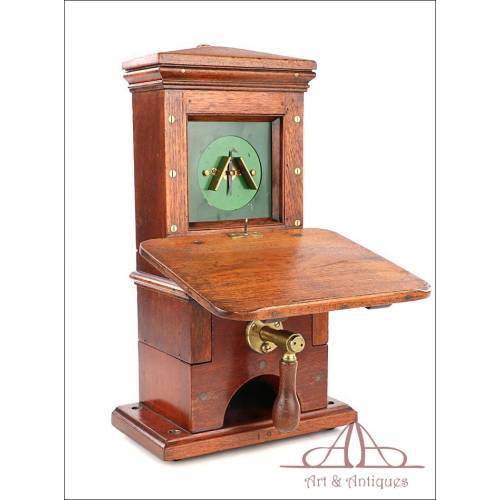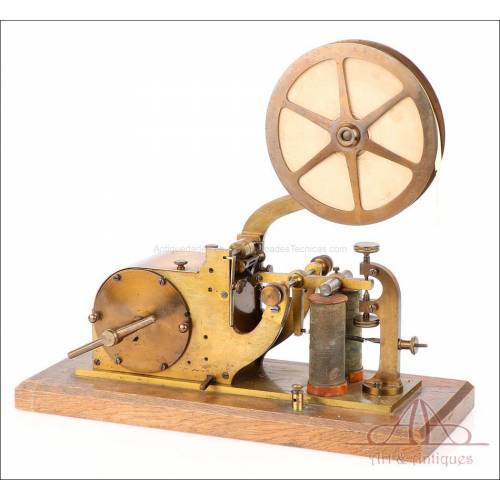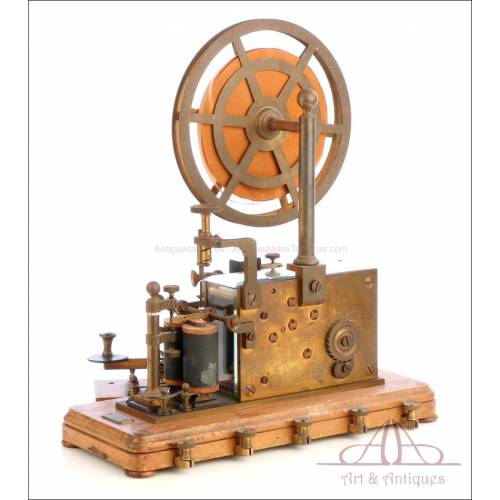Antique Telegraphs
Today it seems impossible that there was a time when there were no means of communicating over distance. But the truth is that until the advent of ancient telegraphs, the only way to contact people and disseminate information was by post. For this reason, the invention of the telegraph can be considered one of the most important in the history o...
Today it seems impossible that there was a time when there were no means of communicating over distance. But the truth is that until the advent of ancient telegraphs, the only way to contact people and disseminate information was by post. For this reason, the invention of the telegraph can be considered one of the most important in the history of mankind. Thanks to this ingenious device, news began to be known quickly and the way of understanding the world was never the same again. Today, fans of collecting antiques related to communications place a special value on antique telegraphs and their components. And no wonder: these are truly fascinating mechanical pieces, which in many cases are still working and keep intact all their power of attraction.
History of antique telegraphs and Morse apparatus
The name "Morse apparatus" is due to the one who is considered the inventor of the telegraph: Samuel F. B. Morse, an American artist born in 1791. However, although Morse was the first to build a telegraph apparatus as we know it today, a series of discoveries and inventions (by figures such as Francisco Calvá y Campillo and Carl Friedrich Gauss) led to the final design. The story goes that Morse decided to invent a device that could transmit information quickly, after learning of the death of his wife a week after the sad event. In addition to designing the device, Morse created the code that bears his name with the help of Henry and Alfred Vail. The inventor built the first telegraph in 1837, and seven years later the first telegraph communication was made. Ancient telegraphs were the first step for the appearance of one of the most important inventions of the last centuries: the telephone.
Parts of an ancient telegraph station
There are two types of telegraph stations: sending stations and receiving stations. The former have keys, also known as pointers, manipulators or boosters, intended to transmit information in Morse code. The receiving stations, on the other hand, have telegraph printers that print the signs received on reels of paper. These signs are then decoded by an operator, who transforms them into words, phrases and messages. Another important element of the receiving station is the galvanometer, a contribution of the English scientist Lord Kelvin thanks to which the first telegraph cable connecting London with New York was put into operation in 1866.
Collecting antique telegraphs
Antique galvanometers, antique Morse keys and antique telegraphs in general are items full of magnetism, with a beauty and interest given by their functionality. Today, antique telegraph stations and their components(together or separately) are part of the most important collections. We can find magnificent pieces in private collections, but also in the most important science and technology museums in the world. Their precision, their intrinsic beauty and the ingenuity displayed by their invention make them true jewels, treasures of a past time that coincided with the advent of Modernity.
Antique Needle Telegraph for Railway Environments. England, Circa 1900 Antique Needle Telegraph for...
Authentic needle telegraph for railway environment in amazing condition. With all its original component parts. Museum piece. Authentic needle telegraph for...
SoldAntique Ericsson Telegraph. Glass Panels. Stockholm, Sweden, Circa 1890 Antique Ericsson Telegraph....
Outstanding Ericsson telegraph with glass panels and wooden base. Gorgeous. In good mechanical working order. Outstanding Ericsson telegraph with...
SoldVery Rare Austrian Schaeffler Telegraphic Printer. Wien, 1870 Very Rare Austrian Schaeffler...
Striking antique Schaeffler telegraphic printer. Very uncommon model. In fine condition. Striking antique Schaeffler...
SoldBeautiful Antique Ericsson Morse Telegraph. Glass Sidewalls. Stockholm, Circa 1900 Beautiful Antique Ericsson Morse...
Amazing antique Morse telegraph in great condition. Perfect as a decorative piece. Fully original. Amazing antique Morse telegraph in...
SoldRare Antique Military Field Telegraph. Copenhagen, Denmark, circa 1900 Rare Antique Military Field...
Amazing and rare antique military telegraph made by Ericsson. In great condition. Entirely original. Amazing and rare antique military...
SoldAntique Italian Telegraph-Morse Station. Italy, Circa 1900 Antique Italian Telegraph-Morse...
Superb telegraph or Morse station in very good condition. With all its original component parts and pieces. Collectors item. Superb telegraph or Morse station in...
Sold
New products
-

Antique ivory and silver plated stethoscope, late 19th century
Antique stethoscope from the late 19th century in silver-plated metal...
-

Vintage pendant with shell cameo of Jesús del Gran Poder, carved c. 1970
Vintage pendant with a shell-carved cameo of Jesus del Gran Poder, circa...
-

Antique Roman Style Gilded Silver Chalice with Paten. France, 1932
Antique Roman-style chalice in gilded silver with paten. France, 1932....
-

Beautiful Antique 18 K Gold Ring with 7 Natural Diamonds
Antique 18K gold ring with 7 natural diamonds. Delicate openwork design,...
-

Antique Silver Reliquary. José Vilaplana. Valencia, Spain. Circa 1920
Impressive repoussé silver reliquary by José Vilaplana, Valencia, c....
-

Vintage 18K Gold Ring with 7 Natural Diamonds
Vintage 18K gold ring with seven natural diamonds in floral setting....
-

Antique Silver Chalice. Enameled Crosses. Valencia, Spain, 1942
Spanish chalice from 1942 in solid silver, gifted by the Church of...
-

Antique Silver Chalice and Paten. Granada Spain, circa 1900
Spanish chalice in white silver with matching paten, handcrafted....
Specials
-

Antique Atlas with 42 Maps. Grand Folio. Complete! 1824
Superb atlas with 42 large-folio...













